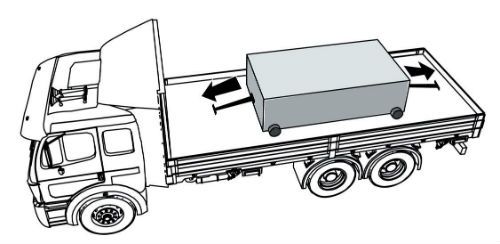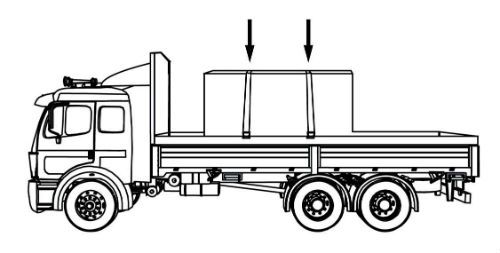CDL Practice Tests: Flatbed Cargo Securement
Choose A Section:
Go!What is a headboard?
- A transverse load bearing structural component, particularly a part of a log bunk.
- A vertical barrier placed directly behind the cab of a tractor to protect the cab in the event cargo should shift forward.
- A vertical barrier across a vehicle to prevent forward movement of cargo.
- A vertical barrier across the front of the deck of a vehicle to prevent forward movement of cargo.
Headboard:
A vertical barrier across the front of the deck of a vehicle to prevent forward movement of cargo.
What is the maximum weight that can be secured by a tiedown with a marked WLL of 5,000 lbs?
- 2,500 lbs
- 6,000 lbs
- 5,000 lbs
- 10,000 lbs
Note: The minimum WLL requirement for the securement system is 50%. More tiedown capacity should be used if you need to secure an article against any movement.
When securing paper rolls with friction mats as a primary method:
- Make sure friction mats are completely covered by the roll.
- All of these answers.
- The friction mat should stick out from underneath the roll in the opposite direction for which it is providing securement.
- The friction mat should stick out from underneath the roll in the direction it is providing securement.
Requirements for friction mats

If a friction mat is used to provide the principal securement for a paper roll, insert the friction mat so that it sticks out from beneath the footprint of the roll in the direction in which it is providing securement.
When securing concrete pipe with a diameter of more than 45 inches loaded crosswise, how many tiedowns are required through each pipe at minimum?
- It depends on the weight of the pipe.
- 3
- 2
- 1
Requirements for securing the pipe
Secure each pipe with tiedowns through the pipe.
Run at least one tiedown through each pipe in the front half of the load. This includes the middle one if there are an odd number. The tiedown must run rearward at an angle not more than 45° with the horizontal when viewed from the side of the vehicle, whenever practicable.
Run at least one tiedown through each pipe in the rear half of the load. The tiedown must run forward at an angle not more than 45° with the horizontal when viewed from the side of the vehicle, whenever practicable. This holds each pipe firmly in contact with adjacent pipe.
All of the following are requirements for dividing vehicles over 33ft except:
- Each tiedown must be fastened below the logs on each side of the center stake.
- Vehicle must be equipped with center stakes or comparable devices.
- Each tiedown must secure the highest log on each side of the center stake.
- Vehicle must be divided by center stakes into sections of staggered length.
Requirements for dividing vehicles over 10m (33 ft)
Vehicles over 10 m (33 ft) must be equipped with center stakes, or comparable devices, to divide it into sections of equal length.
Each tiedown must:
- Secure the highest log on each side of the center stake.
- Be fastened below these logs.
Define 'bolster':
- A crosswise load bearing structural component, particularly a part of a log bunk.
- An inflatable bag intended to fill otherwise empty space between articles of cargo, or between articles of cargo and the wall of the vehicle.
- A structure, device, or another substantial article placed against or around an article to prevent horizontal movement of the article.
- A vertical barrier across the front of the deck of a vehicle to prevent forward movement of cargo.
Bolster:
A crosswise load bearing structural component, particularly a part of a log bunk.
What is bell pipe concrete?
- Pipe whose flanged end is of smaller diameter than its barrel.
- Pipe whose flanged end is of larger diameter than its barrel.
- Pipe used to make concrete bells.
- Concrete used to make bell pipe.
Bell Pipe Concrete:
Pipe whose flanged end is of larger diameter than its barrel.
The definition for "shortwood" identifies pieces that are no longer than:
- The width of the road.
- Half the length of the trailer.
- 75 in
- 16 ft
Shortwood
- Normally up to about 2.5 m (100 in) in length.
- No longer than 4.9 m (16 ft) in length.
-
Also called:
- Cut-up logs
- Cut-to-length logs
- Bolts
- Pulpwood
The narrowest end of a boulder should be pointed:
- Towards the rear of the vehicle.
- It doesn't matter.
- Towards the sky.
- Towards the front of the vehicle.

If a boulder is tapered, point the narrowest end towards the front of the vehicle.
A device placed between the deck of a vehicle and car or between articles of cargo, intended to provide greater friction than exists naturally between these surfaces is:
- Void filler.
- A cleat.
- A friction mat.
- A chock.
Friction mat:
A device placed between the deck of a vehicle and car or between articles of cargo, intended to provide greater friction than exists naturally between these surfaces.
About The Flatbed Cargo Securement CDL Manual
Studying the flatbed cargo securement CDL manual is not a requirement for getting your CDL permit or license. It is required knowledge for flatbed drivers.
Some questions you should be able to answer for flatbed cargo securement:
- What is the minimum Working Load Limit of a tiedown used to secure logs?
- What is the minimum weight of a shipment of paper rolls that would require specific securement requirements?
- When securing concrete pipe over 45 inches loaded crosswise, which direction must the tiedowns on the front half of the load run?
- What is a cab shield?
- When securing concrete pipe over 45 inches loaded crosswise, which direction must the tiedowns on the rear half of the load run?
- What is a dunnage bag?
- Who is responsible for inspecting securing devices and cargo within the first 50 miles?
- How many tiedowns are required on a stack of shortwood loaded crosswise?
- What is the minimum working load limit of each tiedown used to secure crushed or flattened vehicles?
- Define 'bolster'
- What is a hook-lift container?
- When a tiedown is attached directly to the cargo, what is the ideal angle where it attached to the vehicle?
What is a securing device?
Any device specifically manufactured to attach or secure cargo to a vehicle or trailer:
- Synthetic Webbing
- Chain
- Wire rope
- Manila rope
- Synthetic rope
- Steel strapping
- Clamps and latches
- Blocking
- Front-end structure
- Grab hooks
- Binders
- Shackles
- Winches
- Stake pockets
- D-rings
- Webbing ratchet
- Bracing
- Friction mat
What is a tiedown?
A combination of securing devices that forms an assembly that:
- Attaches cargo to, or restrains cargo on a vehicle.
- Is attached to anchor point(s).

Some tiedowns are attached to the cargo and provide direct resistance to restrain the cargo from movement.

Some tie-downs pass over or through the cargo. They create a downward force that increases the effect of friction between the cargo and the deck. This friction restrains the cargo.
 Related Cargo Securement Terms That Every Driver Should Know:
Related Cargo Securement Terms That Every Driver Should Know:
-
Tiedown:
A combination of securing devices which form an assembly that attaches cargo to, or restrains cargo on, a vehicle or trailer, and is attached to anchor point(s).
-
Contained:
Cargo is contained if it fills a sided vehicle, and every article is in contact with or sufficiently close to a wall or other articles so that it cannot shift or tip if those other articles are also unable to shift or tip.
-
Blocking:
A structure, device, or another substantial article placed against or around an article to prevent horizontal movement of the article.
How should tiedowns be attached?
Tiedowns can be used in two ways:
-
Attached to the cargo:
- Tiedowns attached to the vehicle and attached to the cargo.
- Tiedowns attached to the vehicle, pass through or aroundan article of cargo, and then are attached to the vehicle again.
-
Pass over the cargo:
- Tiedowns attached to the vehicle, passed over the cargo, and then attached to the vehicle again.
Tiedown placement:

Place the tiedown as close as possible to the spacer.
Position the tiedowns as symetrically as possible over the length of the article.

Position the tiedowns to preserve the integrity of the article.







 TT On Facebook
TT On Facebook